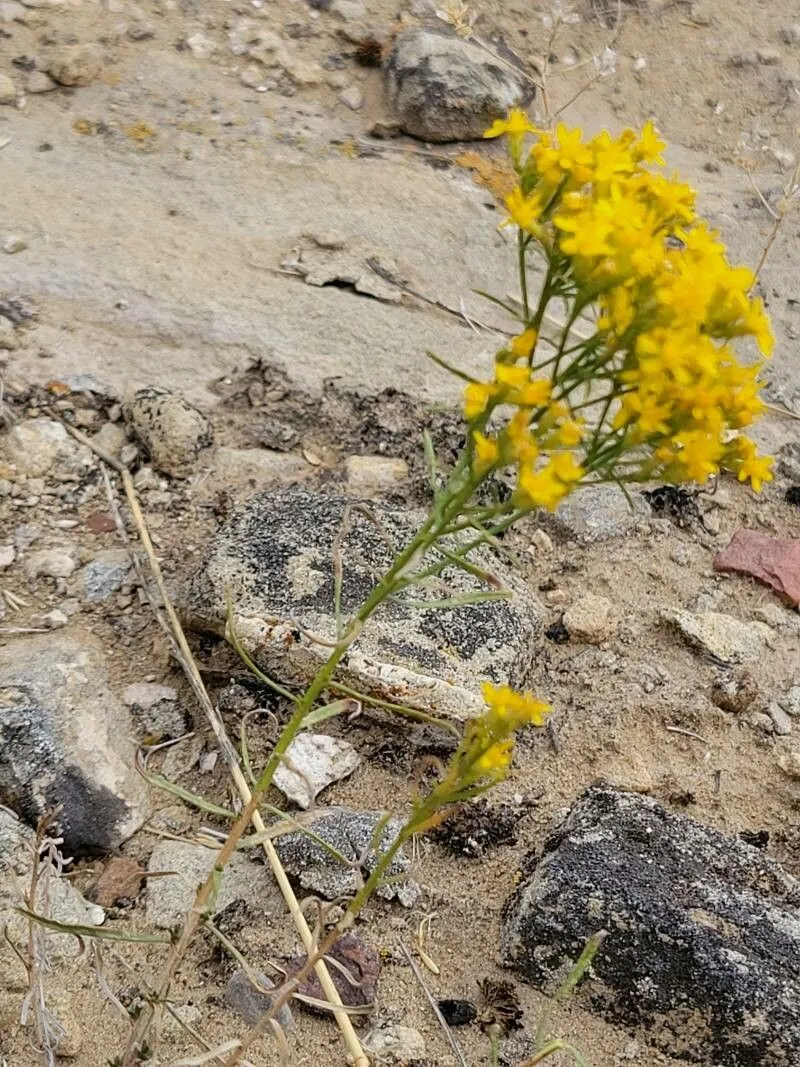
Author: (Pursh) Britton & Rusby
Bibliography: Trans. New York Acad. Sci. 7: 10 (1887)
Year: 1887
Status: accepted
Rank: species
Genus: Gutierrezia
Vegetable: False
Observations: WC. & C. Canada to N. Mexico
Broom snakeweed, scientifically known as Gutierrezia sarothrae, is a hardy and resilient member of the Asteraceae family. This versatile plant can be found thriving in a range of environments, extending from Western and Central Canada all the way down to Northern Mexico. Initially described in the late 19th century, its botanical characteristics and ecological impact were documented in the journal of the New York Academy of Sciences in 1887, with formal classification attributed to botanists Britton and Rusby.
Gutierrezia sarothrae is well-adapted to various climatic conditions and is commonly observed in arid and semi-arid regions. It often dominates landscapes such as grasslands, prairies, and open woodlands, showcasing its golden-yellow flower clusters that exhibit a striking contrast to its green, broom-like stems and leaves. These distinctive blooms not only add aesthetic value but also play a crucial role in the plant’s reproductive cycle, attracting a variety of pollinators essential for its propagation.
Despite its beauty, broom snakeweed is often viewed as a problematic species by ranchers and land managers. Its propensity to proliferate in disturbed soils can lead to extensive coverage, which competes with native grasses and forage plants. Additionally, it possesses allelopathic properties, meaning it can release chemicals into the soil that inhibit the growth of neighboring plants. This characteristic further accentuates its ability to dominate and alter plant communities.
Interestingly, Gutierrezia sarothrae holds historical significance among indigenous cultures who utilized it for medicinal purposes. Traditional remedies crafted from its parts were believed to aid in treating a variety of ailments, although modern science has not extensively validated these uses. However, caution is advised as the plant can be toxic to livestock, notably during certain growth stages.
Ecologically, broom snakeweed contributes to the stability of soil in its native habitats, reducing erosion with its extensive root system. As an integral part of the ecosystem, it also provides cover and food resources for various wildlife species, underscoring its role beyond that of a mere weed.
In summary, broom snakeweed (Gutierrezia sarothrae) is a complex and multifaceted plant. Its wide distribution from Canada to Northern Mexico speaks to its adaptability and ecological significance. While it poses challenges for land management, it also enriches the habitats it inhabits, offering insight into the intricate balance of natural systems.
Eng: broom snakeweed, broomweed, kindlingweed, matchbrush, matchweed, perennial snakeweed, snakeweed, stinkweed, turpentine weed, yellow top, common broomweed
Fra: gutierrézie faux-sarothra
En: Broom snakeweed, Matchbrush, Matchweed, Kindlingweed, Snakeweed, Escoba de la vibora, Broom snakeroot, Broomweed, Perennial snakeweed, Stinkweed, Turpentine weed, Yellow top, Common broomweed
Fr: Gutierrézie faux-sarothra
Taken Dec 24, 2014 by EOL − Keir Morse (cc-by-nc-sa)
Taken Aug 29, 2022 by lauren raspberry (cc-by-sa)
Taken Oct 13, 2020 by Janrik van den Berg (cc-by-sa)
Taken Aug 28, 2022 by Alex Ottovan (cc-by-sa)
Taken Aug 31, 2018 by David Kuhns (cc-by-sa)
Taken Sep 8, 2020 by Kat ♡ (cc-by-sa)
Taken Sep 30, 2021 by Joseph Littlehorn (cc-by-sa)
Taken Sep 13, 2022 by T Trista (cc-by-sa)
Taken Sep 13, 2022 by T Trista (cc-by-sa)
© copyright of the Board of Trustees of the Royal Botanic Gardens, Kew.
© copyright of the Board of Trustees of the Royal Botanic Gardens, Kew.
Growth form: Single Crown
Growth habit: Subshrub, Shrub, Forb/herb
Growth rate: Moderate
Ph maximum: 8.0
Ph minimum: 6.0
Family: Myrtaceae Author: (F.Muell.) K.D.Hill & L.A.S.Johnson Bibliography: Telopea 6: 402 (1995) Year: 1995 Status:…
Family: Rubiaceae Author: Pierre ex A.Froehner Bibliography: Notizbl. Bot. Gart. Berlin-Dahlem 1: 237 (1897) Year:…
Family: Sapindaceae Author: Koidz. Bibliography: J. Coll. Sci. Imp. Univ. Tokyo 32(1): 38 (1911) Year:…
Family: Asteraceae Author: A.Gray Bibliography: Pacif. Railr. Rep.: 107 (1857) Year: 1857 Status: accepted Rank:…
Family: Fabaceae Author: Medik. Bibliography: Vorles. Churpfälz. Phys.-Ökon. Ges. 2: 398 (1787) Year: 1787 Status:…
Family: Aspleniaceae Author: (Cav.) Alston Bibliography: Bull. Misc. Inform. Kew 1932: 309 (1932) Year: 1932…